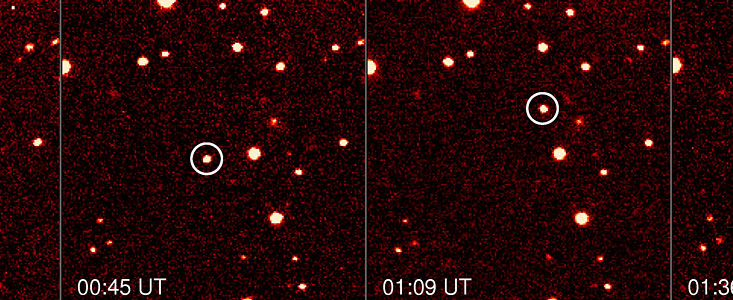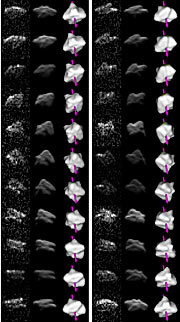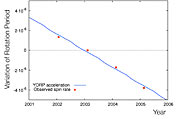Press Release
Solar Power at Play
Observing the Spin-Up of an Asteroid
7 March 2007
For the very first time, astronomers have witnessed the speeding up of an asteroid's rotation, and have shown that it is due to a theoretical effect predicted but never seen before. The international team of scientists used an armada of telescopes to discover that the asteroid's rotation period currently decreases by 1 millisecond every year, as a consequence of the heating of the asteroid's surface by the Sun. Eventually it may spin faster than any known asteroid in the solar system and even break apart.
"The Yarkovsky-O'Keefe-Radzievskii-Paddack (YORP) effect is believed to alter the way small bodies in the Solar System rotate," said Stephen Lowry (Queens University Belfast, UK), lead-author of one of the two companion papers in which this work is reported [1] [2].
"The warming caused by sunlight hitting the surfaces of asteroids and meteoroids leads to a gentle recoil effect as the heat is released," he added. "By analogy, if one were to shine light on a propeller over a long enough period, it would start spinning."
Although this is an almost immeasurably weak force, its effect over millions of years is far from negligible. Astronomers believe the YORP effect may be responsible for spinning some asteroids up so fast that they break apart, perhaps leading to the formation of double asteroids. Others may be slowed down so that they take many days to complete a full turn. The YORP effect also plays an important role in changing the orbits of asteroids between Mars and Jupiter, including their delivery to planet-crossing orbits, such as those of near-Earth asteroids. Despite its importance, the effect has never been seen acting on a solar system body, until now.
Using extensive optical and radar imaging from powerful Earth-based observatories, astronomers have directly observed the YORP effect in action on a small near-Earth asteroid, known as (54509) 2000 PH5.
Shortly after its discovery in 2000, it was realised that asteroid 2000 PH5 would be the ideal candidate for such a YORP detection. With a diameter of just 114 metres, it is relatively small and so more susceptible to the effect. Also, it rotates very fast, with one 'day' on the asteroid lasting just over 12 Earth minutes, implying that the YORP effect may have been acting on it for some time. With this in mind, the team of astronomers undertook a long term monitoring campaign of the asteroid with the aim of detecting any tiny changes in its rotation speed.
Over a 4-year time span, Stephen Lowry, Alan Fitzsimmons and colleagues took images of the asteroid at a range of telescope sites including ESO's 8.2-m Very Large Telescope array and 3.5-m New Technology Telescope in Chile, the 3.5-m telescope at Calar Alto, Spain, along with a suite of other telescopes from Czechia, the Canary Islands, Hawaii, Spain and Chile. With these facilities the astronomers measured the slight brightness variations as the asteroid rotated.
Over the same time period, the radar team led by Patrick Taylor and Jean-Luc Margot of Cornell University employed the unique capabilities of the Arecibo Observatory in Puerto Rico and the Goldstone radar facility in California to observe the asteroid by 'bouncing' a radar pulse off the asteroid and analysing its echo.
"With this technique we can reconstruct a 3-D model of the asteroid's shape, with the necessary detail to allow a comparison between the observations and theory," said Taylor.
After careful analysis of the optical data, the asteroid's spin rate was seen to steadily increase with time, at a rate that can be explained by the YORP theory. Critically, the effect was observed year after year, for more than 4 years. Furthermore, this number was elegantly supported via analysis of the combined radar and optical data, as it was required that the asteroid is increasing its spin rate at exactly this rate in order for a satisfactory 3-D shape model to be determined.
To predict what will happen to the asteroid in the future, Lowry and his colleagues performed detailed computer simulations using the measured strength of the YORP effect and the detailed shape model. They found that the orbit of the asteroid about the Sun could remain stable for up to the next 35 million years, allowing the rotation period to be reduced by a factor of 36, to just 20 seconds, faster than any asteroid whose rotation has been measured until now.
"This exceptionally fast spin-rate could force the asteroid to reshape itself or even split apart, leading to the birth of a new double system," said Lowry.
Notes
[1] Stephen C. Lowry, Alan Fitzsimmons, Petr Pravec, David Vokrouhlicky, Hermann Boehnhardt, Patrick A. Taylor, Jean-Luc Margot, Adrian Galad, Mike Irwin, Jonathan Irwin, and Peter Kusnirak (2007). Direct Detection of the Asteroidal YORP Effect, Published online in Science Express.
[2] Patrick A. Taylor, Jean-Luc Margot, David Vokrouhlicky, Daniel J. Scheeres, Petr Pravec, Stephen C. Lowry, Alan Fitzsimmons, Michael C. Nolan, Steven J. Ostro, Lance A. M. Benner, Jon D. Giorgini, Christopher Magri (2007). Spin Rate of Asteroid (54509) 2000 PH5 Increasing due to the YORP Effect, Published online in Science Express.
Contacts
Stephen Lowry
Astrophysics Research Centre Queen's University Belfast
Belfast, UK
Tel: +44 28 9097-3692
Email: s.c.lowry@qub.ac.uk
Alan Fitzsimmons
Astrophysics Research Centre Queen's University Belfast
Belfast, UK
Tel: +44 7834-318834
Email: a.fitzsimmons@qub.ac.uk
Patrick Taylor
Department of Astronomy Cornell University
Ithaca, USA
Tel: +1 607-255-2727
Email: ptaylor@astro.cornell.edu
Jean-Luc Margot
Department of Astronomy Cornell University
Ithaca, USA
Tel: +1 607-255-1810
Email: jlm@astro.cornell.edu
Hermann Boehnhardt
Max-Planck Institute for Solar System Research
Katlenburg-Lindau, Germany
Tel: +49 5556-979-545
Email: boehnhardt@mps.mpg.de
Petr Pravec
Astronomical Institute AS CR
Ondrejov, Czechia
Tel: +420 323-620352
Email: ppravec@asu.cas.cz
Astronomical Institute AS CR
Ondrejov, Czechia
Tel: +420 737-322815
Email: suchan@astro.cz
About the Release
| Release No.: | eso0711 |
| Legacy ID: | PR 11/07 |
| Name: | 54509 YORP, asteroid 2000 PH5 |
| Type: | Solar System : Interplanetary Body : Asteroid |
| Facility: | New Technology Telescope, Other, Very Large Telescope |
| Instruments: | EMMI, FORS2 |
| Science data: | 2007Sci...316..274T 2007Sci...316..272L |




